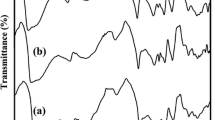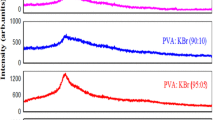Abstract
Li ion conducting polymer electrolyte films were prepared based on poly(vinyl alcohol) (PVA) with 5, 10, 15, 20, 25 and 30 wt% lithium iron phosphate (LiFePO4) salt using a solution-casting technique. X-ray diffraction (XRD) was used to determine the complexation of the polymer with LiFePO4 salt. Differential scanning (DSC) calorimetry was used to determine the melting temperatures of the pure PVA and complexed films. The maximum ionic conductivity was found to be 1.18 × 10−5 S cm−1 for (PVA:LiFePO4) (75:25) film, which increased to 3.12 × 10−5 S cm−1 upon the addition of propylene carbonate (PC) plasticizer at ambient temperature. The Li+ ion transport number was found to be 0.40 for (PVA: LiFePO4) (75:25) film using AC impedance and DC polarization methods. Dielectric studies were performed for these polymer electrolyte films in the frequency range of 10 Hz to 10 MHz at different temperatures. The activation energies of the complexed films were calculated from the dielectric loss tangent spectra and were found to be 0.35, 0.30, 0.27 and 0.28 eV. The cyclic voltammogram (CV) curves of (PVA: LiFePO4) (75:25)+PC film exhibited higher specific capacities than those for other films.









Similar content being viewed by others
References
Arico AS, Bruce P, Scrosati B, Tarascon JM, Schalkwijk WV (2005) Nat Matters 4:366. doi:10.1038/nmat1368
Gray F, Armand M (1999) In: Besenhard JO (ed) Handbook of battery materials. Wiley-VCH, Weinheim, p 499
Abraham KM, Alamgir M (1990) Electrochem Soc 137:1657. doi:10.1149/1.2086749
Alamgir M, Moulton RD, Abraham KM (1991) In: Abraham KM, Salomon M (eds) Primary and secondary lithium batteries. Electrochem Soc, Pennington, p 131
Fan L-Z, Wang X-L, Long F, Wang X (2008) Solid State Ionics 179:1772
Abraham KM, Alamgir M (1991) Chem Mater 3:339. doi:10.1021/cm00014a027
Abraham KM (1993) Chapter 3. In: Scrosati B (ed) Applications of electroactive polymers. Chapman & Hall, London
Croce F, Bonino F, Panero S, Scrosati B (1989) Philos Mag B 59:161. doi:10.1080/13642818908208455
Lebrun L, Silva ED, Metayer M (2002) Appl Polym Sci 84:1572. doi:10.1002/app.10420
Kim DS, Park HB, Rhim JW, Lee YM (2005) Solid State Ion 176:117. doi:10.1016/j.ssi.2004.07.011
Every HA, Zhou V, Forsyth M, MacFarlane DR (1998) Electrochim Acta 43:1465. doi:10.1016/S0013-4686(97)10085-8
Rajendran S, Sivakumar M, Subadevi R (2004) Solid State Ionics 167:335. doi:10.1016/j.ssi.2004.01.020
Kurumova M, Lopez D, Benavente R, Mijangos C, Perena JM (2000) Polymer (Guildf) 41:9265. doi:10.1016/S0032-3861(00)00287-1
Mohan VM, Raja V, Bhargav PB, Sharma AK, Narasimha Rao VVR (2007) J Polym Res 14:283. doi:10.1007/s10965-007-9108-8
Shiun Liao C, Bin Ye W (2003) J Polym Res 10:241. doi:10.1023/B:JPOL.0000004619.00197.7a
Mohan VM, Raja V, Sharma AK, Narasimha Rao VVR (2005) Mater Chem Phys 94:177. doi:10.1016/j.matchemphys.2005.05.030
Mohamad AA, Mohamad NS, AYahya MZ, Othman R, Ramesh S, Alias Y, Arof AK (2003) Solid State Ionics 156:171. doi:10.1016/S0167-2738(02)00617-3
Bhargav PB, Mohan VM, Sharma AK, Narasimha Rao VVR (2007) Int J Polym Mater 56:579. doi:10.1080/00914030600972790
Shao C, Kim H-Y, Gong J, Ding B, Lee D-R, Park S-J (2003) Mater Lett 57:1579. doi:10.1016/S0167-577X(02)01036-4
Joe Hwang B, Chuan Liu Y, Chih Lin H (1997) J Polym Res 4:147. doi:10.1007/s10965-006-0019-x
Sunandana CS, Sentil Kumar P (2004) Bull Mater Sci 27:1. doi:10.1007/BF02708477
Tareev B (1979) Physics of dielectric materials. MIR Publications, Moscow
Ramesh S, Yahana AH, Arof AK (2002) Solid State Ionics 152–153:291. doi:10.1016/S0167-2738(02)00311-9
Pillai PKC, Khurana P, Trilateral A (1986) Mater Sci Lett 5:629. doi:10.1007/BF01731531
Castro WA, Zapata VH, Vargas RA, Mellander BE (2007) Electrochim Acta 53:1422. doi:10.1016/j.electacta.2007.05.066
Rajendran S, Siva Kumar M, Subadevi R (2004) Mater Lett 58:641. doi:10.1016/S0167-577X(03)00585-8
Evans J, Vincent CA, Bruce PG (1987) Polymer (Guildf) 28:2324. doi:10.1016/0032-3861(87)90394-6
Bruce PG, Vincent CA (1987) Electroanal Chem Interf Electrochem 225:1. doi:10.1016/0022-0728(87)80001-3
Panero F, Scrosati B, Sumathipala HH, Wieczorek W (2007) J Power Sources 167:510. doi:10.1016/j.jpowsour.2007.02.030
Mohamed RI (2000) Phys Chem Solids 61:1357. doi:10.1016/S0022-3697(99)00390-X
Yang S, Benitez R, Fuentes A, Lozano K (2007) Compos Sci Technol 67:1159. doi:10.1016/j.compscitech.2006.05.022
Goswami A, Goswami AP (1973) Thin Solid Films 16:175. doi:10.1016/0040-6090(73)90166-1
Rastogi RC, Chopra KL (1975) Thin Solid Films 27:311. doi:10.1016/0040-6090(75)90038-3
Fan L, Dang Z, Wei G, Nan CW, Li M (2003) Mater Sci Eng B 99:340. doi:10.1016/S0921-5107(02)00487-7
Girish kumar G, Munichandraiah N (2002) Electrochim Acta 47:1013
Sonmez G, Schottland P, Reynolds JR (2005) Synth Metals 155:130. doi:10.1016/j.synthmet.2005.07.335
Acknowledgements
One of the authors (V.M. Mohan) wishes to thank Wuhan University of Technology Management for its financial support in the form of a postdoctoral fellowship, which enabled the above work to be carried out. This work is supported by the Chinese Postdoctoral Science Foundation (CPSF; No; 20080440966), the National Nature Science Foundation of China (no. 50672071), and the Program for Changjiang Scholars and Innovative Research Team in University, Ministry of Education, China (PCSIRT) (No. IRT0547).
Author information
Authors and Affiliations
Corresponding author
Rights and permissions
About this article
Cite this article
Mohan, V.M., Qiu, W., Shen, J. et al. Electrical properties of poly(vinyl alcohol) (PVA) based on LiFePO4 complex polymer electrolyte films. J Polym Res 17, 143–150 (2010). https://doi.org/10.1007/s10965-009-9300-0
Received:
Accepted:
Published:
Issue Date:
DOI: https://doi.org/10.1007/s10965-009-9300-0




